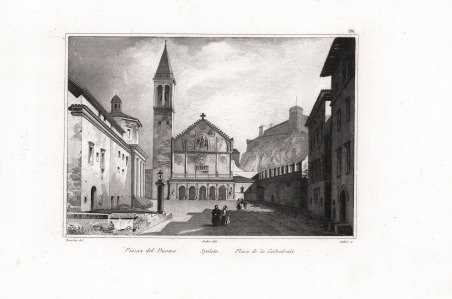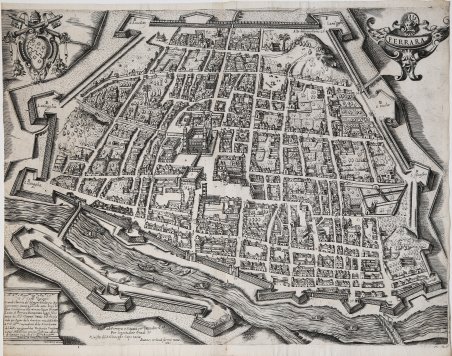In alto a destra, in un cartiglio, troviamo il titolo: FERRARA. Nell’angolo superiore sinistro è rappresentato lo stemma di Clemente VIII. In basso a sinistra, in un cartiglio a forma di basamento di colonna, la dedica: All’ill.mo e Rever mo Sig re e Pat ne Col mo il S r Cardi le S giorgio Grande e la virtu del disengno Poiche puo Rappresentarci Avanti a gli occhi anco le cose lo[n]tane con la forza sua mi trovo haver Ritratto La cita di Ferrara Ricuperata hoggi felicimente da N.S. Clemente Ottavo A.S. chiesa onde per segno de la devotion mia la Dedico A. V.S. ill ma scusandomi della Piccolezza del doNo e pregandolae Prosperita Conforme a suoi Nobilissimi pensieri in Roma a di 29 di Gennaro 1598 D.V.S, ill ma e Rever ma Devoti mo et humil mo servitore Gerolamo dinovo. A destra del basamento si legge: La ciTa di Ferrara è situata per latitudine G di 43 Per longitudine Gradi 33 Rivista dil S.Gioseppe Capocacia. Pianta prospettica della città incisa da Girolamo Dinovo e, come dichiarato nella tavola, “rivista” da Giuseppe Capocaccia. Si tratta della più antica rappresentazione prospettica di Ferrara dalla quale derivano tutte le successive fino al nuovo rilievo di Andrea Bolzoni (1647). ' La pianta fu realizzata in occasione della devoluzione del ducato di Ferrara alla S. Sede, nel gennaio del 1598; in alto a sinistra reca, infatti, lo stemma di papa Clemente VIII, al secolo Ippolito Aldobrandini, celebrato per aver recuperato il ducato allo Stato pontifico. In basso a destra, la dedica al cardinale Giovanni Francesco Blandrate di S. Giorgio.Il primo stato della lastra, avanti l’indirizzo dell’Orlandi e la data 1602, è sconosciuto a tutti i repertori consultati sulla città di Ferrara; ne consegue che la tavola successiva, di Matteo Florimi, che è una chiara e puntuale derivazione di questa, ne venga considerata il prototipo. Benevolo, nel descrivere la copia del Florimi, sottolinea che l’orientamento è scelto in modo tale che la città medievale, con l’asse est-ovest rettificato e disposto in orizzontale, serva da basamento alla città moderna, l’Addizione Erculea. La proiezione obliqua, aumentando la scala degli edifici più densi in primo piano e diminuendo quella degli edifici più radi nello sfondo, rende prospetticamente uniformi le due zone, e presenta l’immagine di una città unitaria, sebbene non riproduca fedelmente la realtà. Il fiume che corre nella parte inferiore, è solo uno dei bracci secondari del Po, che in questo punto si bifora per perdersi nelle valli costiere; ma nell’alto medioevo era uno dei bracci principali, e lungo il suo argine si è formato il primo nucleo della città. La lastra, stampata a Roma come enunciato nel cartiglio, non reca indicazioni editoriali. Probabilmente fu edita da Giacomo Gherardi, erede e successore della calcografia di Claudio Duchetti. Che la lastra fosse appartenuta al Gherardi è dimostrato dalla presenza dell’opera nel catalogo della vedova dell’editore, Quintilia Lucidi, del 17-19 ottobre 1598 (n. 424 descritta come “la Citta di Ferrara”). La matrice venne acquisita, nel 1602, da Giovanni Orlandi che la ristampò inalterata con la sola aggiunta del proprio imprint. Nel 1614, con il trasferimento di Orlandi a Napoli, la matrice fu ceduta a Hendrick van Schoel. ' Giuseppe Capocaccia è forse da identificarsi con il matematico e ingegnere militare di Senigallia che lavorò al servizio di Filippo IV. Girolamo Dinovo o Di Novo, cartografo attivo nel XVI secolo, conosciuto per la carta senza titolo raffigurante il territorio di Ferrara. Del Dinovo, Almagià (1922, p. 25) cita anche una pianta di Ferrara edita a Roma nel 1598. Giacomo Gherardi è stampatore, tipografo e editore originario di Carmagnola, in Piemonte. Attivo a Roma, lavorò per Lorenzo Vaccari e poi per Claudio Duchetti. Nel 1589 fu descritto come “dominus lacobus Gerardus venditor imaginum nella regione Parionis”. La sorella di Gherardi, Margherita, sposò Clau. At the top right, in a cartouche, we find the title: FERRARA. In the upper left corner is represented the coat of arms of Clement VIII. In the lower left corner, in a cartouche in the form of a column base, the dedication: All'ill.mo e Revermo Sig re e Pat ne Col mo il S r Cardi le S giorgio Grande e la virtu del disengno Poiche può Rappresentarci Avanti a gli occhi anco le cose lo[n]tane con la forza sua mi trova haver Ritratto La cita di Ferrara Ricuperata hoggimente felicimente da N. S Clemente Ottavo A.S. chiesa onde per segno de la segno di Ferrara. S. Clemente Ottavo A.S. church onde per segno de la devotion mia la Dedico A. V.S. ill ma scusandomi della Piccolezzazza del doNo e pregandolae Prosperita Conforme a suoi Nobilissimi pensieri in Roma a di 29 di Gennaro 1598 D.V.S, ill ma e Rever ma Devoti mo et humil mo servitore Gerolamo dinovo. To the right of the base we read: La ciTa di Ferrara è situata per latitudine G di 43 Per longitudine Gradi 33 Rivista dil S.Gioseppe Capocacia. Perspective plan of the city engraved by Girolamo Dinovo and, as stated in the table, "revised" by Giuseppe Capocaccia. This is the oldest representation of Ferrara from which all the subsequent ones derive until the new relief by Andrea Bolzoni (1647). The plan was made on the occasion of the devolution of the Duchy of Ferrara to the Santa Sede, in January 1598. At the top left is the coat of arms of Pope Clement VIII, born Ippolito Aldobrandini, celebrated for having recovered the Duchy to the Papal States. The first state of the plate, in front of the address of Orlandi and the date 1602, is unknown to all the repertories consulted on the city of Ferrara; it follows that the next plate, by Matteo Florimi, which is a clear and precise derivation of this one, is considered the prototype. Benevolo, in describing the copy by Florimi, underlines that the orientation was chosen so that the medieval city, with its east-west axis straightened and placed horizontally, would serve as a base for the modern city, the Addizione Erculea. The oblique projection, by increasing the scale of the denser buildings in the foreground and decreasing that of the sparser buildings in the background, makes the two areas uniform in perspective, and presents the image of a unitary city, although it does not faithfully reproduce reality. The river that runs in the lower part, is only one of the secondary arms of the Po, that in this point bifurcates to get lost in the coastal valleys; but in the high Middle Ages it was one of the main arms, and along its bank was formed the first nucleus of the city. The plate, printed in Rome as stated in the cartouche, does not bear editorial indications. It was probably edited by Giacomo Gherardi, heir and successor to the chalcography of Claudio Duchetti. That the plate belonged to Gherardi is demonstrated by the presence of the work in the catalog of the widow of the publisher, Quintilia Lucidi, dated October 17-19, 1598 (n. 424 described as “la Citta di Ferrara”). The plate was acquired, in 1602, by Giovanni Orlandi who reprinted it unchanged with the addition of his own imprint. In 1614, when Orlandi moved to Naples, the plate was bought by Hendrick van Schoel. Giuseppe Capocaccia is perhaps to be identified with the mathematician and military engineer of Senigallia who worked in the service of Philip IV. Girolamo Dinovo or Di Novo, cartographer active in the sixteenth century, known for the untitled map depicting the territory of Ferrara. Giacomo Gherardi was a printer, typographer and publisher from Carmagnola, in Piedmont. Active in Rome, he worked for Lorenzo Vaccari and then for Claudio Duchetti. In 1589 he was described as "dominus lacobus Gerardus venditor imaginum in the region Parionis". Gherardi's sister, Margherita, married Claudio Duchetti. After Claudio's death in 1585, Gherardi was supposed to run the print shop business until Duchetti's son turned 18; if the child died Gherardi would inherit it. Howev. Cfr.


Découvrez comment utiliser
Découvrez comment utiliser

